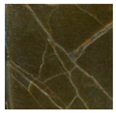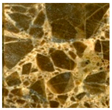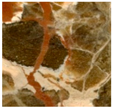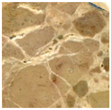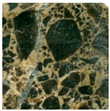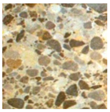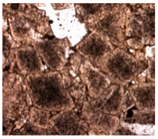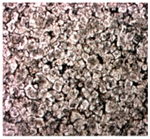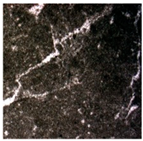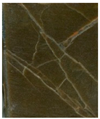Abstract
The aesthetic properties of ornamental stones, including colour, texture, and the presence or absence of discontinuities, are influential in their use and marketing. This is particularly critical in brecciated rocks such as the Marrón Emperador (ME) ornamental stone, a dark brown breccia dolostone (Upper Cretaceous, southeast Spain). ME shows a high chromatic and textural variability, which is one of its most appreciated commercial features. Through a petrographic, mineralogical, geochemical and colourimetric study of samples obtained from quarries, outcrops and/or drilling cores, several quality categories have been established, as well as the relationship between the aesthetic properties of ME ornamental stone with its compositional and textural factors. Three main types of breccia constitute the ME exploitable lithotect: crackle and mosaic packbreccias, and rubble floatbreccias. Breccia clasts are mainly composed of hypidiotopic-idiotopic medium- to coarsely-crystalline dolosparites, microcrystalline dolosparites and dolomicrites. Results show that diagenetic processes are mainly responsible for the colour of ME dolostones, revealing that the Sr content is a key factor. The darker brown dolomites always show a higher Sr content, where other typical chromophore elements in dolomites, such as Fe and Mn, do not present this correlation. This study provides evidence for the complexity of processes and factors that are responsible for aesthetic quality features in ornamental stones.
1. Introduction
Natural ornamental stones possess beauty, durability and stability properties that have made them widely used as decorative and construction rocks throughout history [1,2,3]. There are different factors or criteria for selecting an adequate building rock, such as strength, hardness, porosity, durability or appearance. Importantly, the colour, type and size of grains/crystals, petrofabric features and the presence of “defects” (veins, joints, altered areas, etc.) have great influence on its aesthetic properties, which largely define the market value of these commercial rocks [4,5,6,7].
Carbonate breccias constitute a type of ornamental rock widely used for decorative and architectural purposes since historical times given their particular and attractive visual appearance. Dolomitic breccias are a relatively abundant petrological type in the marine series from different geological periods. These are complex facies with a wide diagenetic history reflected by the presence of clastic characteristics and secondary porosity. Moreover, they show several cementing phases, generally of different compositions and textures. These features entail colour variations that positively affect their ornamental properties.
There are various characteristics of the exploitable lithostratigraphic units as ornamental stone that are directly related to their textural and structural characteristics (geometry of the lithotect, fracturing, homogeneity, colour, etc.) and that determine the dimensions of the blocks to be extracted and the subsequent treatments (cut, polished, etc.) [8,9,10,11]. Nevertheless, the aesthetic criteria are one of the main parameters that define the market quality of ornamental stones. It is particularly important in brecciated stones, where the size, shape and colour of the clasts are keys to set quality categories and prices.
Marron Emperador (ME) commercial marbles are Mesozoic brown brecciated dolostones with high structural complexity, quarried for more than a century in a wide area along External Prebetic Domain (southeast Spain) [9,12]. Because of the attractive appearance of the dark dolostone clasts within the white sparry calcite, this breccia has been widely used as a dimension stone [13]. According to the MIA (Marble Institute of America) classification [14], these materials belong to group C, which correspond to commercial marbles with some variations in their physical properties, commonly used to repair these variations, using adhesives that fill the natural voids and discontinuity surfaces. In dolomitic facies of the Upper Cretaceous, the dark colour is exclusive of some dolostones of the External Prebetic Domain. In other areas, similar dolomitic facies present lighter colours (e.g., “Beige Serpiente” commercial marble) [9].
Several categories are established in the industrial sector, which produces and markets Marrón Emperador (ME) commercial marble. In outcrops, Marrón Emperador shows wide chromatic and textural variations, both laterally and vertically, which make it difficult to draw correlation with brecciaed bodies or lithotects. However, this extreme chromatic and textural variability is very attractive and constitutes one of the most appreciated features of this ornamental stone. Not all brecciated dolostone chromas or varieties are commercial; preferences tend towards mosaic breccia textures, with dark to very dark brown colours (Figure 1). The presence of white calcite veins is another of the characteristics of this material, the customers preferring that this vein network is rather scarce or not very abundant. In the classification by categories, the excessive presence of white veins is assigned a lower commercial category (Figure 1). Moreover, non-breccia or fine-grained textures as well as light colours (e.g., pale brown) are excluded from the commercial preference. Other petrological features that may be present in these stones and that cause them to be excluded in the commercial preference are the presence of [15] (i) calcite enclaves or nodules of up to 10 cm in diameter, sometimes without any filling, which requires the addition of resins in the factory, thereby increasing production costs; (ii) reddish calcite veins enriched in clays from decalcifying processes, and (iii) clay infills, known in mining slang as “dry”, that leads to extremely weak areas and produce a large number of breaks in both loom and tiles.
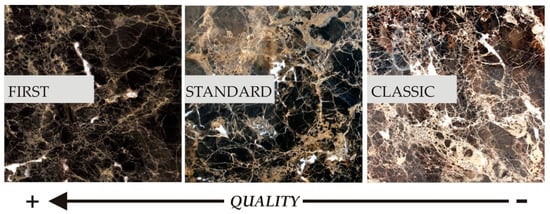
Figure 1.
Varieties of Marrón Emperador commercial marbles marketed by Mármoles Hnos. Jiménez (Spain). https://hnosjimenez.com/marmol-marron-emperador/ (Accessed on: 8 February 2022).
The use of ornamental stones as building materials is mainly due to both their structural (physical–mechanical) and decorative (aesthetic) characteristics. Even being subjective, aesthetic properties such as colour, texture and the degree of homogeneity of both in the stone, are objective and technically measurable parameters, so their study is particularly relevant in ornamental stone exploration tasks, especially for the dimensioning of ornamental stone deposits [4,5,6,9,10]. The main objective of this study is to evaluate the mineralogical, geochemical and petrological factors that affect or control aesthetic quality parameters of Marrón Emperador commercial marble, in order to support the tasks of exploration and even exploitation and processing of these raw materials.
2. Materials and Methods
The geographical area of exploitation of Marrón Emperador (ME) is in the Prebetic domain, the northernmost part of the eastern region of the Betic Cordillera, between the provinces of Murcia, Albacete and Alicante (southeast Spain) [9,12] (Figure 2). Stratigraphically corresponds to the areas in which the Sierra de Utiel Fm, of Upper Coniacian-Upper Santonian age [16,17]. It is dolomitised presenting a massive aspect, very brecciated and a coloration that oscillates between black and gray [18].
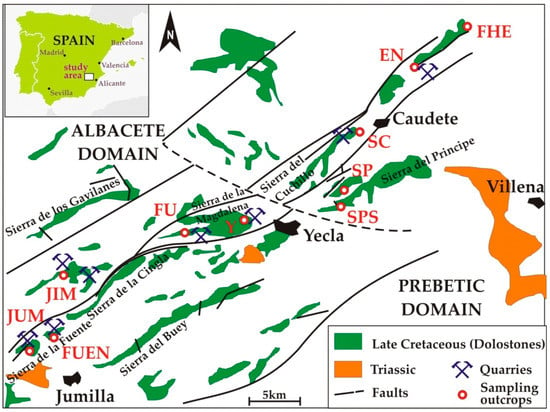
Figure 2.
Distribution of the Late Cretaceous outcrops in the study area where extractions of the “Marrón Emperador” commercial marbles are concentrated. The Mesozoic tecto-sedimentary domains of the Betic Margin, the main tectonic accidents and the situation of the studied sampling outcrops and quarries are indicated. Northeast Sector: FHI-Fuente la Higuera (Valencia); EN-La Encina (Alicante); Central Sector: SC-Sierra del Cuchillo (Albacete); SP- and SPS-Sierra del Príncipe (Murcia); Y-Sierra de la Magdalena Este (Yecla, Murcia); FU-Sierra de la Magdalena Oeste (Murcia); Southwest Sector: JIM-Sierra de la Cingla (Murcia); FUEN-Sierra de la Fuente (Murcia); JUM-Jumilla (Murcia).
Marrón Emperador is a brecciated dolostone essentially formed by dolomite (~70%) and calcite (~30%). This variety is a strongly fissured dolostone that consists mainly of angular micro- and mesocrystalline dolomite clasts with 2 mm to 40 mm in size delimited by fissures (Figure 1). Fissures are frequently filled with calcite (~90%, according to [19]) and dolomite cements, and minority mineral components such as iron and manganese oxides can be present. This stone shows an anisotropic behavior of water transport that depends strongly on fissure orientation and has an essential influence on their quality and durability properties [20,21,22,23,24]. Thus, brecciated dolostones with a preferential fissure orientation present the highest anisotropy.
Marrón Emperador samples (average weight of sample: ≈600 g) were selected from different quarries and outcrops located at north-northeast–south-southwest (NNE–SSW) morfostructural alignment in the provinces of Alicante, Valencia and Murcia (southeast of Spain) (Figure 2). A total of 9 sampling areas or sections (distributed in 3 sectors) were studied. Most of samples were obtained from the quarries where their exploitation occurs. In order to delimit the extension and morphology of the breccia bodies, the sampling area was expanded outside the exploitation areas. Likewise, the investigation was complemented by analysing drilling core samples from prospecting campaigns.
Among the criteria considered during ornamental stones exploration, lithologic characteristic, such as mineral and chemical composition, texture and petrofabric, control their aesthetic properties. As mentioned, colour and homogeneity (colour, texture, discontinuities, etc.) are relevant aesthetic properties in the Marrón Emperador ornamental stone market. In order to know how compositional (mineral and chemical) and textural (crystal size, breccia type, etc.) factors interrelate and control the aesthetic quality parameters (colour, homogeneity, etc.) of the Marrón Emperador commercial marble, a petrological, mineralogical and geochemical characterisation and colourimetric analysis of sampled breccias were carried out.
For the description of the breccia facies, Morrow [25] and Mort and Woodcock [26] classification schemes were followed, whereby the main criteria are the proportion of clast concentration, their degree of rotation and the degree of nesting or adjustment of the clasts, as well as the compositional variety. Thus, the main breccia types were discriminated between clast-supported breccia and matrix-supported breccia, as well as the degree of concentration/rotation of the clasts (from crackle, mosaic and rubble breccia types). The existence and nature of matrix and/or cement in inter-fragmental position was also considered. The classification and description of dolomitic textures was performed according to Gregg and Sibley [27] and Friedman [28] for the nomenclature of dolomite crystal sizes.
Petrographic analyses were accomplished on 150 samples, corresponding to all the sections (outcrops, quarries and boreholes) studied and representative of all the textural types that constitute the ME commercial marble. Thin sections were obtained by standard methods and observed under a Zeiss Axiscop microscope for definition of compositional and textural features. Potassium ferricyanide and alizarin red S staining method was used distinguishing between carbonate minerals [29].
The mineral composition of the samples was determined by X-ray diffraction (XRD) using a Phillips PW1710/00 diffractometer (30 kV, 25 mÅ), using CuKα radiation (1.54054 Å), in the XRD Laboratory of the Department of Geology of the National Museum of Natural Sciences (MNCN-CSIC, Madrid, Spain). For the calculation of % mol MgCO3 of the different carbonate phases, the methods of Goldsmith and Graf [30] and Goldsmith et al. [31] were applied, using quartz as an internal standard and measuring the position of the d(104) peak of the carbonate phases. To establish the degree of ordering of the dolomite crystals, the intensity ratio between 015 and 110 peaks was used [32].
Major-element and minor-element concentrations were determined by inductively coupled plasma atomic emission spectroscopy (ICP–AES) at ACME Analytical Laboratories (Vancouver, Canada) and by means of X-ray fluorescence (XRF) MNCN Laboratories (CSIC, Madrid, Spain). The list of the analysed elements can be consulted in Tables S1 and S2 (Supplementary Materials). The samples were introduced into the spectrometers once pulverised, compacted and pressed to perform a qualitative and semi-quantitative analysis with a series of standards to calibrate any element. Loss on ignition or calcination (LOI) was obtained by calcining the sample in a flask up to 1000 °C and maintaining this temperature for 1 h, and for a series of samples with a small amount of sample, automatic thermogravimetry/differential thermal analysis (TG/DTA) equipment was used.
In the ornamental rock manufacturing industry, the determination of colour is a key aspect for the classification and employability of rocks. The colour determination of the different stone samples was carried out through the use of Munsell’s Rock Colour Chart, both in the field and in the laboratory, and the use of a Minolta CR300 colourimeter. With the colourimeter, colours were measured in the form of three variables: L* (lightness), a* (red/green colour component) and b* (blue/yellow colour component), using the CIELAB measurement method (International Commission on Illumination). This technique was used in circular samples, with a diameter of 60 mm and a thickness of 20 mm, which are perfectly adapted to the measuring equipment, thus avoiding the entry of external light. For the calculation of the chromatic differences (total colour, ΔE) we used the following expression [15,33,34]:
To adapt the colour determinations, the Munsell system was used to carry out statistical calculations; a conversion of H V/C (hue value/chroma) Munsell Colour Coordinates under illuminat C to Cie-L*a*b* System was performed [35,36,37].
3. Results
3.1. Spatial Distribution of Dolomitic Breccia Bodies
The distribution of brecciated facies is comprised in a narrow strip along the Jumilla–Yecla–Caudete–Fuente de la Higuera structural alignment (Figure 2). This tectonic alignment, roughly northeast–southwest (NE–SW), strongly controlled sedimentation in some Upper Cretaceous intervals [18] and also seemed to have played a major role in the dolomitisation and brecciation processes [38,39,40]. At the outcrop scale, the limits of the dolomitic bodies are irregular, locally exceeding the limits of the Sierra de Utiel Fm. itself.
The limestones that surround the dolomitic body locally are also brecciated, indicating that: (i) brecciation and dolomitisation are not genetically related or (ii) at least one phase of brecciation is subsequent to the dolomitisation of the Sierra de Utiel Limestones Fm. That means the distribution of the dolomitic bodies indicates that during brecciation and dolomitisation processes, the sedimentological or stratigraphic control was not the main factor.
The central sector of the study area comprises four sections (Figure 2), three of them located in the province of Murcia (Sierra de la Magdalena, Yecla and Sierra del Príncipe) and one in Albacete (Sierra del Cuchillo). At the Sierra de la Magdalena (FV) quarry and the boreholes samples from the Sierra del Cuchillo area, dolostone packbreccias arranged in metric-thick beds are the main dolostone facies. In the outcrops studied in the Sierra del Principe section (SP, SPS), in addition to the most abundant brecciated types, complex brecciated dolostone facies and micritic packbreccias with incipient dolomitisation are present. At the Yecla quarries (Y) (Figure 3A), conglomerate facies are also recognised.
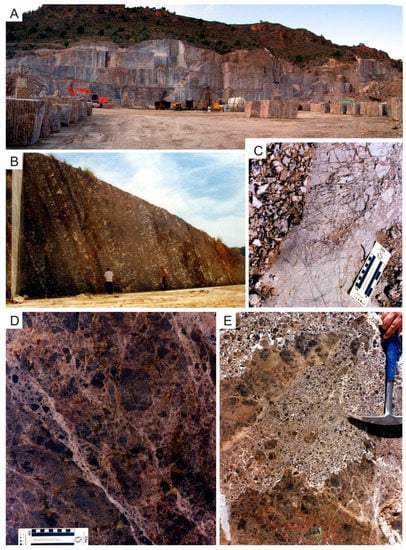
Figure 3.
Field images of the main outcrops and breccia types recognised in the study area. (A) General view of Marrón Emperador quarry at Sierra de la Magdalena (Yecla, Murcia) (Y section, central sector). (B) General view of Marrón Emperador quarry at Sierra de Cingla (Murcia) (JIM section, southeast sector). (C) Crackle breccia (Sierra del Príncipe, Murcia) (SP section, central sector). (D) Mosaic breccia (La Encina, Alicante) (EN section, northeast sector). (E) Chaotic breccia (La Encina, Alicante) (EN section, northeast sector).
The southeast (SE) sector of the study area comprises three sections (Figure 2) located in the province of Murcia, which correspond to three quarries where the Marron Emperador commercial marble is exploited or prospected. At Jumilla quarry (JUM), dolostone breccias are arranged in metric-thick beds with a dip varying 20 to 30° to the north. At Sierra de la Fuente quarry (FUEN), dolostone breccias are recognised in decimetric to metric-thick beds, as well as locally, polymictic conglomerate levels. At the Hermanos Jimenez quarry (Sierra de Cingla, JIM) (Figure 3B) dolostone packbreccia beds are characterised by the abundance of veins and/or macrocrystalline calcite infillings (“flowers”) showing a subvertical decimetric development that highlights the stratification in the quarry fronts.
The northeast sector of the study area comprises two sections or groups of outcrops. At La Encina quarries (EN), dolostones appear as dark massive metric-thick beds with great lateral continuity, where the main dolostone breccia types are recognised. Late Cretaceous outcrops in the Fuente de la Higuera (FHI) area consist of a succession of clear massive decimetric to metric-thick dolostone beds. Within the fractured areas, irregular dolostone breccia bodies appear showing darker tones.
3.2. Breccia Types
According to the clast concentration ratio and the degree of mutual proximity and rotation of clasts [25,26], the main types of breccia recognised are (Table 1): crackle packbreccias (clast-supported, little relative displacement of clasts; CB) (Figure 3C), mosaic packbreccias (clast-supported, largely but not wholly displaced clasts; M) (Figure 3D) and chaotic or “rubble” floatbreccias (matrix-supported, completely disordered and no clast boundaries match; RB) (Figure 3E). These main types of identified breccias are widely represented in all sectors of the study area (Table 1). Associated with them, the other three types of breccia/conglomerate facies recognised with a more local spatial distribution are: conglomerate facies (FUEN section, at the southwest sector; Y section, at the central sector), complex brecciated facies (Mv) (JUM section, at the southwest sector; SP section, at the central sector) in which several brecciation phases are recognised, and Micritic mosaic packbreccia with incipient dolomitisation (Mm) (SP section, at the central sector) (Table 1).

Table 1.
Types and distribution of breccia facies in the study area. The number of collected samples for each breccia category in the studied sections is included.
In the recognised clast-supported breccia types, the presence of mineral cement compared to the fine-grained matrix is significantly higher (Figure 3C–E). Mainly, cements are arranged in a network of white veins and venules (Figure 3C–E), mainly composed of micro- to mesocrystalline calcite crystals (50–800 μm) showing blocky or drusy textures. To a lesser extent, these venules are formed by idiotopic to subidiotopic mesocrystalline dolomite cements (50–250 μm). Reddish calcite veins enriched in clays are relatively abundant in some mosaic breccia types (Mv, Mm). Likewise, some small micritic-clay fill and/or ferruginous patina associated with the cements are observed. The fine-grained matrix has a lighter colouration than dolomite clasts and is mainly composed of dolosparite and dolomicrite grains, with a very scarce presence of siliciclastic grains (e.g., quartz). Locally, this matrix is relatively rich in clays and/or iron oxide-hydroxides.
3.3. Dolostone Types
Table 2 shows the main features of the dolostone fabrics recognised in breccia clasts. The predominant dolomite textures are medium- to coarsely-crystalline dolosparites composed of hypidiotopic (planar-s) mosaics with crystals rich in impurities (Figure 4A,B), the idiotopic (planar-e) (Figure 4C,D) and microcrystalline types (Figure 4E,F) being less abundant. The dolomite crystals sometimes show rhombic and subrhombic zones (delimited by alignments of inclusions or impurities) (Figure 4A,C,D) or simply emphasised nuclei (more or less of rhombic morphology) (Figure 4E), the existence of limpid edges being common, either in planar-e and planar-s dolosparites (Figure 4A,D,E). Likewise, ghosts of allochems and venules are relatively frequent (Figure 4B), as well as textures of mimetic and non-mimetic dedolomitisation (Figure 4D).

Table 2.
Main features of dolostone petrofabrics and their distribution in the study area.
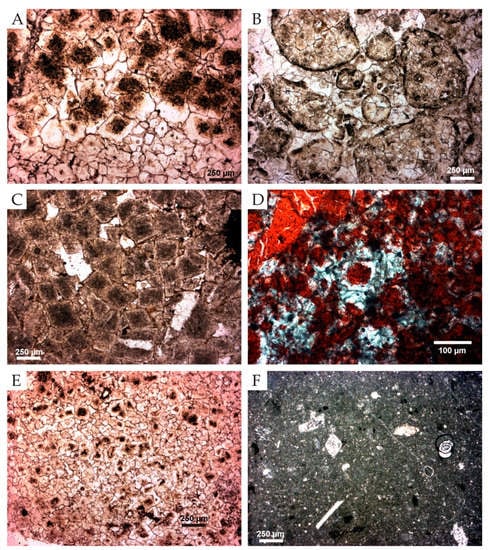
Figure 4.
Dolomitic textural types and their distribution by sections. (A,B) Mesocrystalline dolosparites. Medium- to coarsely-crystalline dolosparites composed of hypidiotopic (planar-s) mosaics with crystals rich in impurities, often showing zoned and emphasised nuclei (A). Ghost of allochems and venules (B) are also recognised, as well as mimetic and non-mimetic dedolomitisation textures. (C,D) Rhombic dolosparites. Medium- to coarsely-crystalline dolosparites composed of idiotopic (planar-e) mosaics with rhombic crystals rich in impurities. Often these rhombic and subrhombic dolomite crystals are zoned, have internal holes, or are dedolomitised (D). Mimetic and non-mimetic dedolomitisation textures are present (D). (E) Microscrystalline dolosparites. Finely-crystalline dolosparites composed of unimodal (20–150 μm) hypidiotopic mosaics with subhedral to anhedral (plana-s) crystals. Generally, the thickest crystals show impurity-rich internal areas. (F) Dolomicrites composed of crypto-microcrystalline (4–20 μm) hypidiotopic mosaics with disperse subrhombic dolomite crystals. Non-mimetic dedolomitisation textures are present. (A) (JUM section); (B,C,E) (Y section); (D) (SP section); (F) (JIM section).
The morphology and distribution of the porous system is predominantly intercrystalline (0.01–1 mm) and bound to dissolution surfaces of clear crystallographic control. In addition to intercrystalline porosity, fissure and stylolite porosity types have also been recognised. The network of fissures, sometimes linked to venules and stylolites, is locally dense and complex, crossing or delimiting dolomitic clasts and reflecting several fracturing processes (Figure 5A,B). These fissures (mesoscale fractures) can be found partially open with openings that rarely exceed 1 mm in width. Mártinez-Mártinez et al. [19] determined that total porosity in these materials ranges between 1 and 8%, depending on the presence of fissures and the matrix content. The mean radius of the pores is greater than 2 µm. The permeability of these materials is relatively low (<1 mD) [22], reflecting a low interconnection in the porous system.
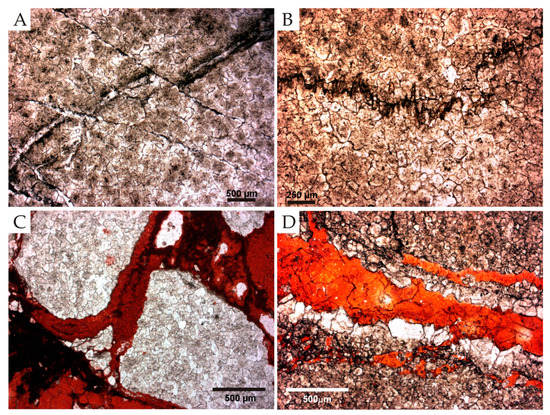
Figure 5.
Discontinuities and cements in Marrón Emperador breccia facies. (A) Network of fissures and veinlets in mesocrystalline hypidiotopic dolosparite (Y section). (B) Stylolite in mesocrystalline hypidiotopic dolosparite (Y section). (C) Equant calcite cements occluding interparticle and fracture porosity in dolosparite (SPS section). (D) Dolomite and calcite cements filling fracture porosity (Y section).
As aforementioned, one of the main features of these rocks that adds aesthetic value as an ornamental stone is that the dolomitic clasts are frequently surrounded by crystalline calcite cement (Figure 5C,D). These cements, which constitute the networks of white venules of different development, occur mainly in the clast-supported breccia facies (crackle and mosaic packbreccias) (Figure 3). Multiple phases of calcitic cementation are recognised, mainly blocky or equidimensional type, in some cases growing on previous dolomite cements (Figure 5D).
3.4. Mineral Composition
The different microfacies studied have different contents in carbonate mineral phases (calcite and dolomite) (Table 3) and generally show very low content in other types of minerals. Content > 5% in quartz or feldspar is rarely detected. The “crackle” breccias, which show a concentration of clasts of more than 75%, show the highest percentages in dolomite, in some cases close to totality. Mosaic and chaotic (rubble) breccias also have high contents of dolomite, but it must be taken into account that both matrix and cements, at least partially, may have a dolomitic composition. Given the low or no content in other mineral phases that are not calcite or dolomite, the calcite content of all breccia types is inversely proportional to the dolomite content, the matrix-supported types being the richest in calcite, reaching 45%.

Table 3.
Mineralogical composition of brecciated microfacies in the study area.
The analysed dolomites are not stoichiometric, and show an enrichment in Ca with % molCaCO3 values ranging from 50.3 to 56.1 (62% of samples between 53 and 55% molCaCO3). No relation between the stoichiometry of the dolomites, the dolomite textural types or the breccia fabric has been recognised (Figure 6). Both the calcitic crystals associated with dolosparites, as well as those that make up venules and speleothems are LMC (<4% molMgCO3).
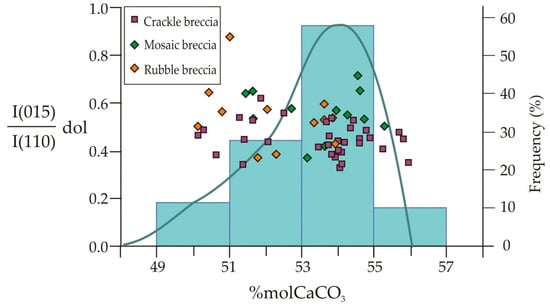
Figure 6.
Degree of ordering of the analysed samples. Order ((I (015)/I (110)) vs. stoichiometry (% molCaCO3).
Regarding the degree of ordering of the dolomites, a direct relationship with their stoichiometry is not observed (Figure 7). The main recognised breccia types show the same variability in the degree of ordering (Figure 6), it can only be noted that the dolosparitic mosaics associated with the “crackle” breccias appear less ordered.
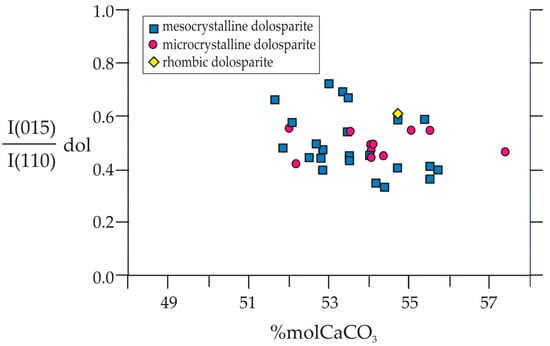
Figure 7.
Order ((I (015)/I (110)) vs. stoichiometry (% molCaCO3) diagram corresponding to the dolostone types from Sierra del Cuchillo (SC) section.
3.5. Geochemistry
Table 4 show the main statistical parameters of the chemical composition of the dolomitic samples analysed. Geochemical analyses are given in Tables S1 and S2 (Supplementary Materials).

Table 4.
Chemical composition of dolostones (n: 48). Statistical parameters. (SD: standard deviation).
Regarding the stoichiometry of the dolomites, the geochemical data are consistent with those obtained from XRD analyses, that is, the studied dolomites are Ca-rich (Table 4, Tables S1 and S2—Supplementary Materials). Both Fe and Mn content are relatively low (% Fe2O3 between 0.1 and 0.42; Mn below 100 ppm in most samples) (Figure 8). Si and Al contents are also low, indicating the scarce presence of silicate phases in the studied materials. With respect to the rest of the major elements analysed, Cl contents in dolosparites are relatively low (>250 ppm), although the dolomicrosparitic subtype shows a greater range of composition (100–450 ppm). On the contrary, Na concentration is relatively high (220–3100 ppm).

Figure 8.
Mg/Ca vs. Fe2O3 and Sr plots from the dolostones of the main breccia microfacies corresponding to all the studied sections.
Sr in the dolomitic phases vary between 132 and 268 ppm (Figure 8), presenting a good correlation with the Mg and Ca contents. However, no discrimination of the aforementioned groups (breccia types and dolomitic petrographic types) is observed in terms of Sr content.
The contents in other trace elements are not significant, being on many occasions below the analytical detection limit. For example, chalcophilic elements sensitive to environmental redox conditions, such as As, Mo, Ni or Zn have a very low concentration (<10 ppm) as well as U (<10 ppm), Rb (0.5–5 ppm) and Ba.
The calcite cements analysed, such as the dolomites, show similar values in Fe content and are significantly lower in Si, Al, Na and K. As in dolomites, the relative high Sr values (175–610 ppm) also stand out.
3.6. Colour Analysis
Tables S3 and S4 (Supplementary Materials) shows the results of the chromatic analysis carried out on the Sierra del Cuchillo samples (global samples) and dolomite clasts (all sections), respectively.
The results of the colourimetric study reveal the great chromatic variety of the samples studied. Dolostone clasts colour range in lightness (L*) from pale to dark (reddish) brown. As expected, the studied total samples have a light colour and less colour variability because of the quantities of matrix and calcite cements, with L* values between 36.9 and 51.3 (Table S3, Supplementary Materials). Lightness of dolomite clasts varies from 20.4 to 80.7 (Table S4, Supplementary Materials). With the classification of the samples according to the Munsell system, it has been possible to analyse the colour of the dolomitic clasts, avoiding the high luminosity effect of the white venules. Figure 9 shows the correlation of the two systems used by converting the Munsell categories to the L* a* b* scale, as well as with ΔE (Chromatic or total colour difference), based on the CIElab system analysed with a colourimeter.
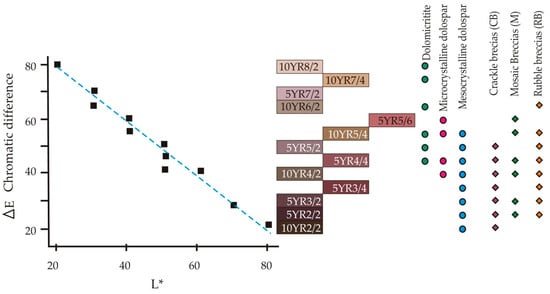
Figure 9.
Correlation of colour parameters of the dolomite clast samples (Table S4, Supplementary Materials) according to Munsell and CIELab systems.
Analysing only the dolomitic clasts (different shades of brown), the spectrum of Munsell colour categories, and their equivalents in the L* b* a* scale is much larger. For example, within the browns there are darker terms (5YR3/2; 5YR2/2; 10YR2/2) that correspond to a numerically lower colour quality (chromatic difference). From the point of view of the textural types, it is observed that these darker browns correspond to mesocrystalline dolostones (Figure 9). Regarding the breccia type, no chromatic discrimination is observed. Regarding the mineralogical composition (ordering and stoichiometry) of the dolomites, there is no obvious correlation with colour (Figure 10).

Figure 10.
Colour vs. dolomite ordering and stoichiometry of the Sierra del Cuchillo del Cuchillo samples (Table S3, Supplementary Materials).
4. Discussion
Ornamental stone is commercially classified on the market according to several factors related both to intrinsic petrophysical properties and to their aesthetical attributes. The use of ornamental stones as construction material with decorative functions makes their aesthetic properties prevail in quality criteria definition and assessment [41]. Colour is considered one of the most important properties of these materials, and in the case of Marron Emperador, the dark brown colour is therefore one of the most important features commercially. Traditionally, the brown colour of dolostones has been attributed to the fact that iron is present in small amounts replacing magnesium in dolomite. The colour in carbonate rocks is controlled by depositional and diagenetic conditions (including those derived from weathering) [42]. In the colouration of soils, sediments and rocks, not only the existence of certain chemical elements in the structure of the mineral phases is important, but also the existence and quantity of the non-carbonate fraction present; for example, the adsorption of Fe and Mn on the surface of intercrystalline clays or as part of compounds with Fe3+ (hematite, limonite), all of them directly related to the redox conditions of the depositional and/or diagenetic environment.
Different diagenetic factors and/or processes that can induce colour in rocks are compaction, which favors the circulation of oxidizing fluids through the sediments; dissolution by pressure (deep-burial diagenesis) that releases Fe from clays; or the replacement processes (e.g., dedolomitisation) that can mobilise Fe from the dolomites, precipitate of FeO(OH), that are subsequently oxidised to Fe2O3 with the consequent reddening of the rock [42,43].
From the colourimetric analysis of the Sierra del Cuchillo samples, a series of categories were established based on the calculation of the total colour difference (chromatic difference, ΔE) factor. In the specific case of ME, the production and distribution companies establish categories and varieties based on the colour and homogeneity of the rock, the density and typology of the calcite veinlets (Figure 1). A review of the categories and qualities created by the companies in the ornamental stone sector that produces and markets ME, as well as the reports of consulting companies [15], has enabled a quality category according to colour for Marrón Emperador in southeastern Spain to be established (Table 5). Three main commercial categories of Marrón Emperador have been established, from lowest to highest quality: classic, standard and first. Out of range, and therefore not commercial, are very dark tones, practically black (with values <36), or too light, with ranges greater than 48.

Table 5.
Commercial categories based on chromatic classification in ME ornamental stone.
Figure 11 shows the classification of the samples from the Sierra del Cuchillo boreholes. Most of the samples analysed have a good or very good chromatic quality, which points to a good potential for the exploitation of this lithotect as an ornamental stone. Figure 10 also shows the equivalence of the qualities based on the L* a* b* system to the Munsell scale, as well as the textural typology of the dolostones studied. There is no clear discrimination between the textural type and the chromatic quality established by the colourimetric analysis of the samples.
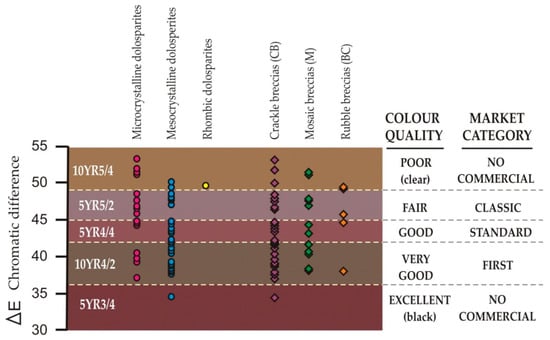
Figure 11.
Chromatic characterisation of the Sierra del Cuchillo samples and chromatic classification.
Considering both textural and colour homogeneity as aesthetic quality parameters, the presence of white calcite veins increases the luminosity and therefore the value of the chromatic difference, although not its commercial category. This variation in texture means that some visually attractive samples, due to their vein networks, and that are considered high quality (price), have a lower quality in terms of colour classification. In contrast, a non-breccia, uniform, dark brown texture may obtain low luminosity values, although the sample is of poor commercial quality, and it is therefore assigned to a lower category.
With the classification of the samples according to the Munsell system (Figure 9), it has been possible to analyse the colour of the dolomitic clasts, avoiding the high luminosity effect of the white venules. Considering only the dolomitic clasts (different shades of brown), the spectrum of Munsell colour categories, and their equivalents in the L* b* a* scale is much larger. For example, within the browns appear darker terms (5YR3/2; 5YR2/2; 10YR2/2) that correspond to a numerically lower colour quality (higher quality). Regarding the breccia type, no chromatic discrimination is observed. Texturally, these darker browns correspond to mesocrystalline dolosparites (Figure 11).
However, some studies describe the effect of grain/crystal size of carbonates (e.g., Gaffey [44]), indicating that carbonates commonly have a darker colour the more fine-grained they are, in part because organic matter can be more homogeneously dispersed in rocks of small grain size [45]. Tseni et al. [46] suggested that increasing organic components in carbonate rocks have a negative affection on their brightness or dullness.
The mineralogical and geochemical analyses of the analysed dolostones reveal the high complexity of the diagenetic history suffered by the Marrón Emperador commercial marble [39,47]. From a geochemical point of view, Fe content is not directly related to the chromatic quality of the studied samples (Figure 12) although it is considered as the main cause of the brown colour of carbonates [35,44,48]. However, there is a direct relationship with Sr content (Figure 12). Samples with Sr content higher than 200 ppm always correspond to commercial marbles of good and very good quality from the point of view of their colour. Other chemical elements (transition metals) with potential as chromophores or those that can induce darkening, such as vanadium, nickel or cobalt [49,50], have not been detected in significant proportions in the analysed samples.
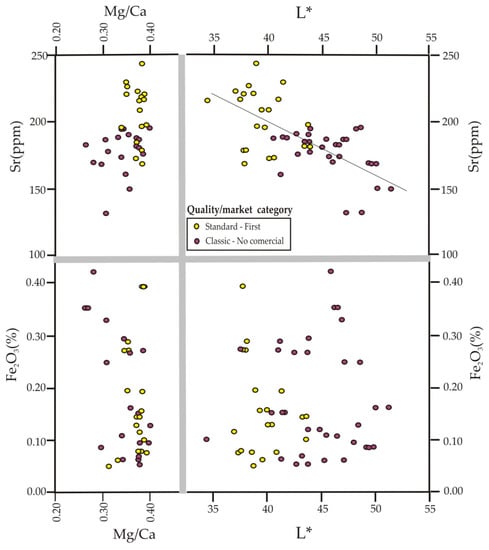
Figure 12.
Sr y Fe2O3 vs. L* and Mg/Ca plot showing the relationship between the chemical composition of the ME dolostones and their commercial categories.
Sr appears to act as a chromophore element (such as other transition elements), darkening the tone of the dolomites. This darkening action of Sr has been observed in other mineral compounds, such as talcs [50]. Sr contents in dolomites can be interpreted in terms of the composition of the diagenetic fluids or the efficiency of recrystallisation processes. Based on this, the most valuable “Marrón Emperador” types in terms of colour would correspond to rocks with a lower degree of recrystallisation.
5. Conclusions
Different types of breccia and dolomitic fabrics constitute the Marrón Emperador ornamental stone. Through a petrographic, mineralogical, geochemical and colourimetric analysis of the main commercial varieties of this stone, the relationship of these compositional and textural factors with its aesthetic properties has been studied. This work highlights the difficulty of tracing or stablishing the origin of the aesthetic properties of ornamental stones. The colour of a rock and its variability (changes in hue, chroma, etc.) depend on the interrelation of several factors. In the case of Marrón Emperador, the results indicate that Sr content is a determinant factor, which in turn indicates that complex diagenetic processes are responsible not only for its breccia nature, but also for its colour properties. Likewise, results showed that other compositional (e.g., dolomite stoichiometry) or textural (e.g., type of dolospar mosaics) factors of Marrón Emperador ornamental stone do not clearly control their characteristics of colour and homogeneity, which are considered to be its main aesthetic quality properties.
Supplementary Materials
The following supporting information can be downloaded at: https://www.mdpi.com/article/10.3390/app12052566/s1, Table S1: Chemical composition (ICP) of Marron Emperador breccia dolostones. Samples from quarries; Table S2: Chemical composition (XRF) of Marron Emperador breccia dolostones. Samples from Sierra del Cuchillo section; Table S3: Chromatic analysis data from Sierra del Cuchillo section (central sector). Global samples; Table S4: Chromatic analysis from dolomitic clasts.
Author Contributions
Conceptualisation, M.C.M.-C. and J.C.C.; investigation, M.C.M.-C., M.Á.R.-G. and J.C.C.; writing—original draft preparation, M.C.M.-C. and J.C.C.; writing—review and editing, J.C.C.; visualisation, M.Á.R.-G.; supervision, J.C.C. All authors have read and agreed to the published version of the manuscript.
Funding
This research received no external funding.
Institutional Review Board Statement
Not applicable.
Informed Consent Statement
Not applicable.
Data Availability Statement
Not applicable.
Conflicts of Interest
The authors declare no conflict of interest.
References
- Calvo, J.P.; Regueiro, M. Carbonate rocks in the Mediterranean region—From classical to innovative uses of building stone. In Limestone in the Built Environment: Present-Day Challenges for the Preservation of the Past; Special, Publications; Smith, B.J., Gomez-Heras, M., Viles, H.A., Cassar, J., Eds.; Geological Society of London: London, UK, 2010; Volume 331, pp. 27–35. [Google Scholar]
- Cooper, B.J. The ‘Global Heritage Stone Resource’ designation: Past, present and future. In Global Heritage Stone: Towards International Recognition of Building and Ornamental Stones; Special, Publications; Pereira, D., Marker, B.R., Kramar, S., Cooper, B.J., Schouenborg, B.E., Eds.; Geological Society of London: London, UK, 2015; Volume 407, pp. 11–20. [Google Scholar]
- Pereira, D.; Marker, B. The value of original natural stone in the context of architectural heritage. Geosciences 2016, 6, 13. [Google Scholar] [CrossRef]
- Carvalho, J.F.; Henriques, P.; Falé, P.; Luís, G. Decision criteria for the exploration of ornamental-stone deposits: Application to the marbles of the Portuguese Estremoz Anticline. Int. J. Roc. Mech. Min. Sci. 2008, 45, 1306–1319. [Google Scholar] [CrossRef]
- Cosi, M. The dimension stone sector: New perspectives on the global market and on the reporting of international mining standards. Eur. Geol. 2015, 39, 24–30. [Google Scholar]
- Cosi, M. A new valuation method for dimension stone mining projects and properties. In Proceedings of the 20th Extractive Industry Geology Conference 2018 and Technical Meeting, Durham, NC, USA, 12–15 September 2018; Anderson, P.E., Hunger, E., Brown, T.J., Wardrop, D., Horsley, N., Eds.; EIG Conferences Ltd.: Warwick, UK, 2019; pp. 70–89. [Google Scholar]
- Badouna, I.; Koutsovitis, P.; Karkalis, C.; Laskaridis, K.; Koukouzas, N.; Tyrologou, P.; Patronis, M.; Papatrechas, C.; Petrounias, P. Petrological and Geochemical Properties of Greek Carbonate Stones, Associated with Their Physico-Mechanical and Aesthetic Characteristics. Minerals 2020, 10, 507. [Google Scholar] [CrossRef]
- Shadmon, A. Stone—An Introduction, 2nd ed.; Intermediate Technology Publications: London, UK, 1996; 172p. [Google Scholar]
- García del Cura, M.A.; Rodríguez, M.A.; Pina, J.A.; Cañaveras, J.C.; Baltuille, J.M.; Ordóñez, S. Los mármoles comerciales “Marrón Imperial” y “Marrón Emperador” (S.E. España). Caracterización petrológica y criterios de exploración. Boletín Geológico Y Min. 1999, 110, 67–76. [Google Scholar]
- Mosch, S.; Nikolayew, D.; Ewiak, O.; Siegesmund, S. Optimized extraction of dimension stone blocks. Environ. Earth Sci. 2011, 63, 1911–1924. [Google Scholar] [CrossRef]
- Luodes, H.; Kauppila, P.M.; Luodes, N.; Aatos, S.; Kallioinen, J.; Luukkanen, S.; Aalto, J. Characteristics and the environmental acceptability of the natural stone quarrying waste rocks. Bull. Eng. Geol. Environ. 2012, 71, 257–261. [Google Scholar] [CrossRef]
- Rodríguez García, M.A.; García del Cura, M.A.; Muñoz Cervera, M.C.; Cañaveras, J.C. Recursos de rocas ornamentales en los términos de Jumilla y Yecla (Murcia). Macla 2005, 3, 173–175. [Google Scholar]
- Mitchel, C.; Bide, T.; Ellison, R.; Lott, G.; Lacinska, A.; Parry, S.; Entwisle, D. Assessment of the Dimension Stone Resources of the UAE; The Geology and Geophysics of the United Arab Emirates; British Geological Survey: Nottingham, UK, 2012; Volume 11, 212p. [Google Scholar]
- Harben, P.; Purdy, J. Dimension stone evaluation. Ind. Miner. 1991, 281, 47–61. [Google Scholar]
- Georock, S.L. Investigación Geológico Minera P.I. Cuchillo nº1678, Caudete (Albacete). Unpublished Technical Report, 27p & Annexes. 2004. Available online: https://rua.ua.es/dspace/bitstream/10045/63390/6/tesis_maria_concepci%C3%B3n_mu%C3%B1oz_cervera.pdf (accessed on 22 January 2022).
- Del Pozo, J.R.; Martín-Chivelet, J. Bioestratigrafía y cronoestratigrafía del Coniaciense-Maastrichtiense en el sector Prebético de Jumilla-Yecla (Murcia). Cuad. Geol. Ibérica 1994, 18, 83–116. [Google Scholar]
- Luperto Sinni, E.; Martin Chivelet, J.; Giménez, R. Praemurgella Valenciana nov. gen. et sp. (Foraminifera) In the Sierra de Utiel Formation (Coniacian-Santonian) of the Prebetic Domain (SE Spain). Geobios 2000, 33, 145–151. [Google Scholar] [CrossRef]
- Martin-Chivelet, J. Las Plataformas Carbonatadas del Cretácico Superior de la Margen Bética (Altiplano de Jumilla—Yecla, Murcia). Ph.D. Thesis, Universidad Complutense de Madrid, Madrid, Spain, 1992; 899p. [Google Scholar]
- Martínez-Martínez, J.; Benavente, D.; García del Cura, M.A. Multivariate statistical techniques for evaluating the effects of brecciated rock fabrics on ultrasonic waves propagation. Int. J. Rock Mech. Min. 2008, 45, 609–620. [Google Scholar] [CrossRef]
- Martínez-Martínez, J.; Benavente, D.; García del Cura, M.A. Petrographic quantification of brecciated rocks by image analysis. Application to the interpretation of elastic wave velocities. Eng. Geol. 2007, 90, 41–54. [Google Scholar] [CrossRef]
- Benavente, D.; Martínez-Martínez, J.; Cueto, N.; García del Cura, M.A. Salt weathering in dual-porosity building dolostones. Eng. Geol. 2007, 94, 215–226. [Google Scholar] [CrossRef]
- Cueto, N.; Benavente, D.; García del Cura, M.A. Influence of anisotropy on rock hydrical properties. Analysis of brecciated dolostones from Betic Cordillera (Spain). Geogaceta 2006, 40, 315–318. [Google Scholar]
- Cueto, N.; Benavente, D.; García del Cura, M.A. Estimation of water permeability of building brecciated dolostones. In Proceedings of the 7th International Symposium on the Conservation of Monuments in the Mediterranean Basin “Water and Cultural Heritage”, Orleans, France, 6–9 June 2007; pp. 119–129. [Google Scholar]
- Cueto, N.; Benavente, D.; Martínez-Martínez, J.; García del Cura, M.A. Rock fabric, pore geometry and mineralogy effects on water transport in fractured dolostones. Eng. Geol. 2009, 107, 1–15. [Google Scholar] [CrossRef]
- Morrow, D.W. Descriptive field classification of sedimentary and diagenetic breccia fabrics in carbonate rocks. Bull. Can. Pet. Geol. 1982, 30, 227–229. [Google Scholar]
- Mort, K.; Woodcock, N.H. Quantifying fault breccia geometry, Dent Fault, NW England. J. Struct. Geol. 2008, 30, 701–709. [Google Scholar] [CrossRef]
- Gregg, J.M.; Sibley, D.F. Epigenetic dolomitization and the origin of xenotopic texture. J. Sediment. Petrol. 1984, 54, 908–931. [Google Scholar]
- Friedman, G.M. Terminology of crystallization textures and fabrics in sedimentary rocks. J. Sediment. Petrol. 1965, 35, 643–655. [Google Scholar]
- Lindholm, R.C.; Finkelman, R.B. Calcite staining, semiquantitative determination of ferrous iron. J. Sediment. Petrol. 1972, 42, 239–245. [Google Scholar] [CrossRef]
- Goldsmith, J.R.; Graf, D.L. Relation between lattice constants and composition of the Ca-Mg carbonates. Am. Miner. 1958, 43, 84–101. [Google Scholar]
- Goldsmith, J.I.; Graf, D.L.; Heard, H.C. Lattice constants of the calcium-magnesium carbonates. Am. Miner. 1961, 46, 453–457. [Google Scholar]
- Hardy, R.; Tucker, M.E. X-ray powder diffraction of sediments. In Techniques in Sedimentology; Tucker, M.E., Ed.; Blackwell Scientific Publications: Hoboken, NJ, USA, 1988; pp. 191–228. [Google Scholar]
- CIE. Colorimetry, 2nd ed.; No. 15.2; CIE Publications: Vienna, Austria, 1986. [Google Scholar]
- Antal, A.; Görög, P.; Veres, A.L.; Balla, P.; Török, A. Colour of stone slabs under different standard Illuminations. Period. Polytech. Civ. Eng. 2017, 61, 66–74. [Google Scholar] [CrossRef]
- Benavente, D.; Martínez-Verdú, F.; Bernabeu, A.; Viqueira, V.; For, R.; García del Cura, M.A.; Illueca, C.; Ordoñez, S. Influence of surface roughness on colour changes in building stones. Color Res. Appl. 2003, 28, 343–351. [Google Scholar] [CrossRef]
- Mahyar, F.; Cheung, V.; Westland, S. Different transformation methods between CIELAB coordinates and Munsell hue. Color Technol. 2010, 126, 31–36. [Google Scholar] [CrossRef]
- Vodyanitskii, Y.N.; Kirillova, N.P. Conversion of Munsell Color Coordinates to Cie-L*a*b* System: Tables and Calculation Examples. Mosc. Univ. Soil Sci. Bull. 2016, 71, 139–146. [Google Scholar] [CrossRef]
- Muñoz-Cervera, M.C.; Rodríguez-García, M.A.; García del Cura, M.A.; Cañaveras, J.C. Dolomías brechoides ornamentales (Marrón Emperador) del Cretácico superior de la Sierra del Cuchillo (Albacete). Geotemas 2007, 10, 1171–1174. [Google Scholar]
- Muñoz-Cervera, M.C.; García del Cura, M.A.; Cañaveras, J.C. Caracterización isotópica (δ13C y δ18O) de las dolomías brechoides del Cretácico Superior del Prebético Externo en el sector Jumilla-Yecla. Macla 2007, 7, 51. [Google Scholar]
- Muñoz-Cervera, M.C. Génesis de Mármoles Comerciales “Marrón Emperador” y “Marrón Imperial” (Cretácico Superior, Prebético Externo, Sector Jumilla-Yecla-Fuente de La Higuera). Ph.D. Thesis, Universidad de Alicante, Alicante, Spain, 2016; 224p. [Google Scholar]
- Bonifazi, G.; Gargulio, A.; Serranti, S.; Raspi, C. Imaging-based logics for ornamental stone quality chart definition. In Proceedings of the Machine Vision Applications in Industrial Inspection XV, San Jose, CA, USA, 29–30 January 2007; Volume 6503. [Google Scholar]
- Flügel, E. Microfacies of Carbonate Rocks. Analysis, Interpretation and Aplication; Springer: Berlín, Germany, 2004; 976p. [Google Scholar]
- Mattes, B.W.; Mountjoy, E.W. Burial dolomitization of the Uper Devonian Miette buildup, Jasper National Park, Alberta. In Concepts and Models of Dolomitization; Zenger, D.H., Dunham, J.B., Ethington, R.L., Eds.; SEPM Special Publications; SEPM Society for Sedimentary Geology: Tulsa, OK, USA, 1980; Volume 28, pp. 259–297. [Google Scholar]
- Gaffey, S.J. Spectral reflectance of carbonate minerals in the visible and near infrared (0.35–2.55 microns): Calcite, aragonite, and dolomite. Am. Miner. 1986, 71, 151–162. [Google Scholar]
- Kjolle, I. Industrial mineral quality of limestone: The effect of contact metamorphism on textural properties, brightness and geochemistry. NGU-Bulletin 2000, 436, 85–91. [Google Scholar]
- Tseni, X.; Tsikouras, B.; Hatzipanagiotou, K. Suitability assesment of carbonate rocks from the Kataraktis Passage Member of the Olonos-Pindos zone (Ileia Pefecture, western Greece) for industrial applications. Bull. Geol. Soc. Greece 2013, XLVII, 2059–2068. [Google Scholar] [CrossRef][Green Version]
- Muñoz-Cervera, M.C.; García-del-Cura, M.A.; Cañaveras, J.C. A diagenetic study of ‘Marron Imperial’ dolostones (Upper Cretaceous, prebetic Domain, SE Spain). In Abstracts, 28th IAS Meeting of Sedimentology; Bádenas, B., Aurell, M., Alonso-Zarza, A.M., Eds.; IAS-Zaragoza University: Zaragoza, Spain, 2011; p. 530. [Google Scholar]
- Deer, W.A.; Howie, R.A.; Zussman, J. An Introduction to the Rock-Forming Minerals; Longman Scientific & Technical: Essex, UK, 1992. [Google Scholar]
- Burns, R.G. Mineralogical Applications of Crystal Field Theory, 2nd ed.; Cambridge Topics in Mineral Physics and Chemistry; Cambridge University Press: Cambridge, UK, 1993. [Google Scholar]
- Soriano, M.; Sánchez-Marañón, M.; Melgosa, M.; Gámiz, E.; Delgado, R. Influence of chemical and mineralogical composition on color for commercial talcs. Color Res. Appl. 2002, 27, 430–440. [Google Scholar] [CrossRef]
Publisher’s Note: MDPI stays neutral with regard to jurisdictional claims in published maps and institutional affiliations. |
© 2022 by the authors. Licensee MDPI, Basel, Switzerland. This article is an open access article distributed under the terms and conditions of the Creative Commons Attribution (CC BY) license (https://creativecommons.org/licenses/by/4.0/).
